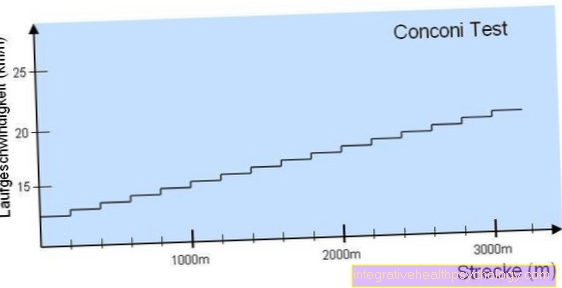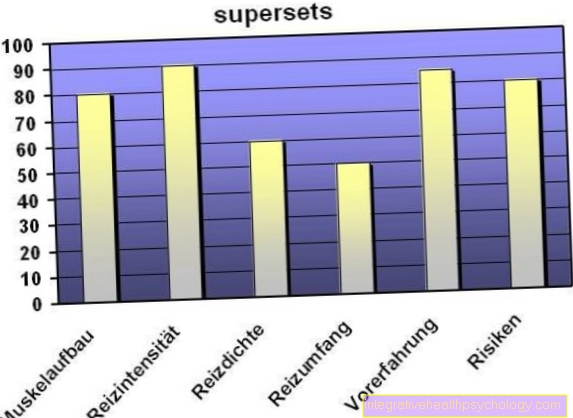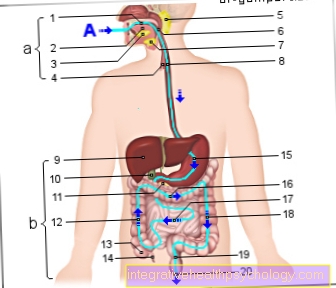Conconi test
Synonyms in the broadest sense
Endurance test, step test,
introduction

The Conconi test was developed by the Italian biochemist Francesco Conconi. As with all other endurance tests, the Conconi test tries to determine the anaerobic threshold for endurance exercise in order to be able to draw conclusions about endurance performance and trainability. In this test, the athlete has to increase the running speed or driving speed increasingly evenly at equal intervals. The test is therefore particularly suitable for endurance athletes at the beginning of the training phase. Another, very precise determination of the anaerobic threshold is done with the lactate level test. However, this test is not entirely bloodless, as blood must be taken regularly to determine the lactate level in the blood. You can find more information about the lactate level test here.
further test:
- Cooper test
adoption
Conconi assumes that the Heart rate increases linearly in the aerobic range. This range is approx. 100-180 beats / minute. If the load is increased further, the course of the curve will flatten. That point where the curve flattens out Deflection point called and determines the anaerobic threshold. The athlete / trainer can now adjust the intensity (Running speed / driving speed) precisely during training.
Test execution
To carry out the Conconi test you need:
- Heart rate monitor
- stopwatch
- Signal generator (whistle)
- 400m track / bicycle ergometer
- Paper and pen
On the track
The athlete begins with a general warm-up program.
The 400m lane is divided into 2x 200m, the running speed should be chosen appropriately at the beginning of the test. Untrained athletes choose a speed of approx. 8 km / h, whereby trained people can start with 12-13 km / h. The running speed is increased by 0.5 km / h every 200 meters, or the athlete runs the 200 meters 2 to 3 seconds faster. The trainer gives a signal at which the athlete should reach the marker (at 200m). A certain feeling of running from the athlete is required. Heart rate is determined every 200m and entered in a table. Various heart rate monitors can save the heart rates
The test is carried out until the subject can no longer increase the speed, so that at least 2 to 3 values are measured after the anaerobic threshold (up to the maximum load). The test in halls is best suited to avoid the possible wind resistance.
The test person should increase the speed as constantly as possible (do not sprint the last piece to the marking).

On the exercise bike:
The athlete completes a warm-up program here too.
At the beginning of the test, the resistance should be between 25 and 100 watts, depending on the line level.
In untrained athletes, the resistance is increased by 20 watts every 2 minutes. Trained athletes increase the value by approx. 30-50 watts. With every increase in resistance, the heart rate is measured and noted.
The Conconi test for cyclists
The Conconi test for cyclists is on one Exercise bike carried out. The start intensity depends on the individual performance and can be 50 watts, 75 watts or 100 watts. The first Load level lasts two minutes on. At all further load levels care is taken that the same work is done per level. But that also means that the load times will be shorter. Often times each level is incorrectly loaded for two minutes, but this is more the case with the lactate level test. In addition to the endurance component, the Conconi test on the bicycle ergometer also strength endurance is an important point. The bicycle Conconi test is always "Indoor" performed to the Environmental conditions hold as close as possible.
Evaluation of the Conconi test
The evaluation one Conconi tests can with one computer based program take place (Polar, HRCT or InShape). This is a graphic created that Heart rate and power in km / h or watt. The so-called Deflection speed at which the initially straight heart rate kinks. According to Conconi, this kinking is to be equated with the anaerobic threshold. The Curve which is shown in the graphic is often for those with good endurance training s-shaped and consists of a flat area at the beginning of the test. This is followed by a steeper anaerobic zone followed by the deflection point where the heart rate flattens out again.
In addition to the computer-based evaluation, you can also use the Conconi test manually evaluate. To the data pairs of heart rate and speed are entered in a diagram. Millimeter paper is best for making precise entries.
trouble can contact the Determination of the break point because the experience of the examiner is important here. In addition, the test requires the test person to work to the maximum, as the values are otherwise not meaningful.
The following points must be met:
- 8 points in the linear range with a correlation coefficient of r³ 0.98
- at least 3 points above the anaerobic threshold
- Increase in heart rate by at least 8 beats per level

analysis
Like many other endurance tests, the Conconi test reached its limits. Only the relationship between performance and heart rate is measured. Lactate levels are left out. The results are individual and cannot be generally asserted. Reading the deflection point is usually very imprecise. For thorough endurance performance diagnostics, various tests should be performed at regular intervals. It is important that the trainers are not dogmatists. Performance diagnostics only provide a framework for trainability and nothing more.
Criticism of the Conconi test
Criticism of the Conconi test is especially loud when it comes to carrying out the Conconi test as a field test and not under laboratory conditions.
The problem is that the athlete needs a very good sense of tempoto complete the different levels. Only competitive athletes who have enough experience are suitable for this. But also here are not all of them are able to maintain the correct pace over time at every stageso that at the end it is often necessary to sprint or the athlete reaches the target marking too early. It arise Heart rate jumpswhich complicate the evaluation. This in turn falsifies the Conconi test. The Conconi test in the field is therefore not suitable for beginners. Another point of discussion is whether the Conconi threshold really corresponds to the anaerobic threshold. Hence the Conconi test for many Not a real alternative to the lactate level testwhen it comes to determining the anaerobic threshold.
The Conconi test does not necessarily bend at the anaerobic threshold, and it is not always possible to clearly identify the bend. Here is a lot of experience necessaryto interpret the results.
Therefore, the Conconi test is inferior to a lactate level test or a VO2max measurement.
Further information
You can get more here information to this topic:
- endurance
- Endurance and fat burning
- Endurance sports at home
- Perseverance in adolescence
- Cooper test
- marathon
- Triathlon
- speed
- Strength training
- Performance diagnostics
- Running analysis





























